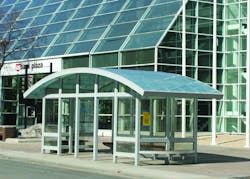Covering Customers at the Stop
Transit companies are finding that bus shelters mean much more than simply a place for riders to sit and wait for the next bus.
“The squared-off, bubble-dome shelters are going by the wayside,” says Patrick Merrick, executive vice president of Tolar Manufacturing. “We’re doing a lot more custom shelters, a lot of European shapes and solar designs.
“The demand now is for more aesthetically pleasing shelters that blend into the streetscape.”
Bus companies are finding that shelters provide a branding tool that allows others, who may not be taking a bus, to put a face on the transit system.
“Each community, whether it’s Detroit or Los Angeles or anywhere else, they’re all looking for something distinctive,” Merrick says. “The most visible aspect for a transit system other than its buses is its street structures. It’s important that they’re clean and attractive.”
That shift in shelters has led many companies that manufacture bus shelters to expand their product lines. Most shelter manufacturers have grown their product lines to meet the increase in demand for visually pleasing structures.
“Communities want out-of-the-box thinking about bus shelters, especially customized designs,” says Michael Arvidson, executive vice president of Duo-Gard Industries, Inc. “They want shelters to make a signature branding statement that sets the community apart as it encourages and supports the burgeoning growth in public transportation. And even within the same city, we’re seeing requests for distinctly different shelters in each district’s streetscapes.”
Many transit systems are looking for shelters that seat many bus riders at a large stop, but there are smaller stops that often leave riders with no place to sit or find shelter from the shade.
“I noticed a lot of bus riders having very uncomfortable waits at the bus stops where conventional bus stops could not be installed because of a lack of space,” says John Bright, the CEO of Sombrero Shelters LLC. “I saw riders sheltering under trees from the sun or trying to keep dry when it rained and felt it was time these riders had some form of shelter from the basic elements.”
That’s what led Bright to develop the Sombrero Shelter, a one-column covered design that offers a compact shelter for those awaiting a bus. The shelters offer a two-person seating option or what it calls a butt bar for riders to lean against while waiting for a bus.
“Installation is simple and it needs just one hole to be dug,” Bright says. “It can also be positioned directly behind the sidewalk so no concrete pad is required as the canopy reaches over the sidewalk without obstructing it.”
Despite the size of the shelter, manufacturers are adding solar capabilities to their bus shelters. It’s providing a cost-effective option for transit systems, as the cost of electricity is decreased.
“We’re making a big deal out of it because it’s relatively inexpensive for us to put in a solar panel,” says Mel Cohen, president of Handi-Hut, Inc. “Not only can you light up the shelter, but we have the ability to back-light ads as well.
“We can also retrofit many shelters that are in existence now with solar lighting. Transit shelters might have lighting, and we can supply a solar panel and the wiring to put into existing shelters to update not only the advertising but the lighting.”
Handi-Hut can back-light advertising panels on the bus shelters, which offers those wishing to advertise the ability to reach a greater audience, as those driving by can see the ad from their cars during the night.
Solar lighting is just one of several “green” ideas offered by shelter manufacturers. Some manufacturers are offering benches and shelters made entirely of recycled materials, while others are making their shelters out of recyclable materials. And a powder-coating process instead of standard painting is more eco-friendly, producing no volatile organic compounds (VOC) into the air.
Powder-coating is also a way to curb vandalism, as it is more difficult to etch than normal paint.
For the Sombrero Shelter, vandalism is more difficult as there is less to damage than a standard shelter. Plus, it is designed in a way to keep the structure intact.
“There is very little to damage,” Bright says. “The post can be repainted if needed or covered with an anti graffiti lacquer, and the canopy is reinforced fiberglass and almost 8 feet high. It is also designed so people cannot hang off the edge.”
And shelter manufacturers are continuing to develop new amenities for shelters as communities try to encourage more and more riders to their mass transit systems.
“I believe the current advances in bus shelters are a foretaste of much more to come as we increase our reliance on mass transportation,” Arvidson says.






